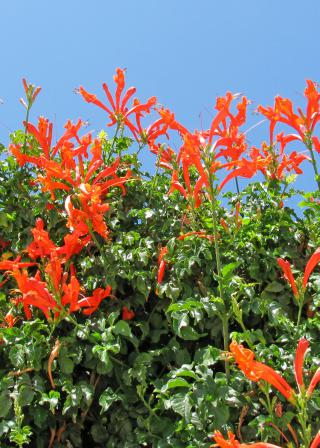Ornamental or landscape trees are often planted to improve the aesthetics of your property or to improve environmental conditions such as shading a sunny area, providing a wind-break, etc. Because trees are long-term investments, it is important to select trees that are suitable to the climate, soil type, site, and light/ wind conditions of the planting location. Initial placement, planting method, and ongoing care can all influence the health and longevity of the tree.
Ornamental Trees and Shrubs

Question:
I have a 'Globe Willow' that has a dark-colored sap running down the bark. I seem to be coming from under the wood near the crotch of the tree. What is the cause of this? I see some insects in this sap. Is there a bore causing the damage? The dark sap is dripping on my patio and discoloring the flagstones. What can I do?
Answer
Your tree is suffering from a disorder called slime flux or wet wood. These two diseases are thought to be bacterial infections, however these diseases are poorly understood. The water soaked, discolored appearance with constant bleeding of the sap at or below the branch crotches and trunk are the visual symptoms of this disease. Liquid may seep out of cracks or wounds and run down the bark. The liquid contains microorganisms that will cause the liquid to ferment and become dark in color, sticky and smelly and some insects may feed on it. Pressure can build up under the bark from fermentation and cause splitting and cracking. Normally the disease is not observed in young trees probably because of rapid growth which makes invasion of bacteria and fungi rare. Generally trees are at least 5 years old and have developed heartwood become infected. Wilting and die back of branches may occur. Younger trees may have leaves that yellow, wilt or curl, turn colors and then drop early. Susceptible trees grown in Arizona include: ash, (Fraxinus species), elms (Ulmus species), poplars (Populus species), willows (Salix species), mulberry (Morus species), and mesquite; common, honey and chilean (Prosopis species).
Slime flux infection can aggravate wounds and cause death of bark cambium. This disease may need to be controlled in large specimen trees. Holes may be drilled to relieve pressure under the bark. Drill a 1/4 or 1/2 inch hole at an upward angle below the bleeding and insert a plastic tube snugly and permanently into the first inch or two of the hole. This reduces the internal pressure and facilitates drainage of the fermented toxic material. Remove any dead or weak branches. Fertilize and water to keep the tree in a vigorous state. For the stains on your flagstone place a piece of cardboard or plastic to catch the dark liquid. If the stone is stained perhaps bleaching would help.
Question:
I have a young spruce tree that is drying up on one side. The needles are falling off and part of the tree is bare. The tree is watered well. The tree is planted three feet from the northwest side of the house. What is the problem?
Answer
The tree is probably infected with spider mites. This can be determined by placing a white piece of paper under a branch while giving the branch a quick tap. Spider mites will be dislodged, fall on the paper and look like little speck running around. These animals are not insects but arachnids, members of the spider family. With a magnifying glass you can see that these tiny creatures have two body parts: a head and a abdomen, and eight legs. There are numerous species of mites, both harmful and beneficial. Spider mites thrive in hot, dry weather. Trees planted to close to a house will try and push the house over! Also the afternoon sun reflects heat off of the house on to the tree and provides a perfect environment for mites.
If proper cultural practices are used predacious mites normally control harmful mites. If mites become a problem washing them off with a hard stream of water can help destroy small infestations. Dormant oil sprays applied during early spring also help keep mites in check. Dusting sulfur is labeled for mites and is an organic treatment. Care must be used when using sulfur during high temperatures because burning of plant tissue may occur. Chemical miticide are available to control sever infestations. Registered products include Kelthane (dicifol), and Omite (propargite). Always follow the label instructions when using any pesticide.

